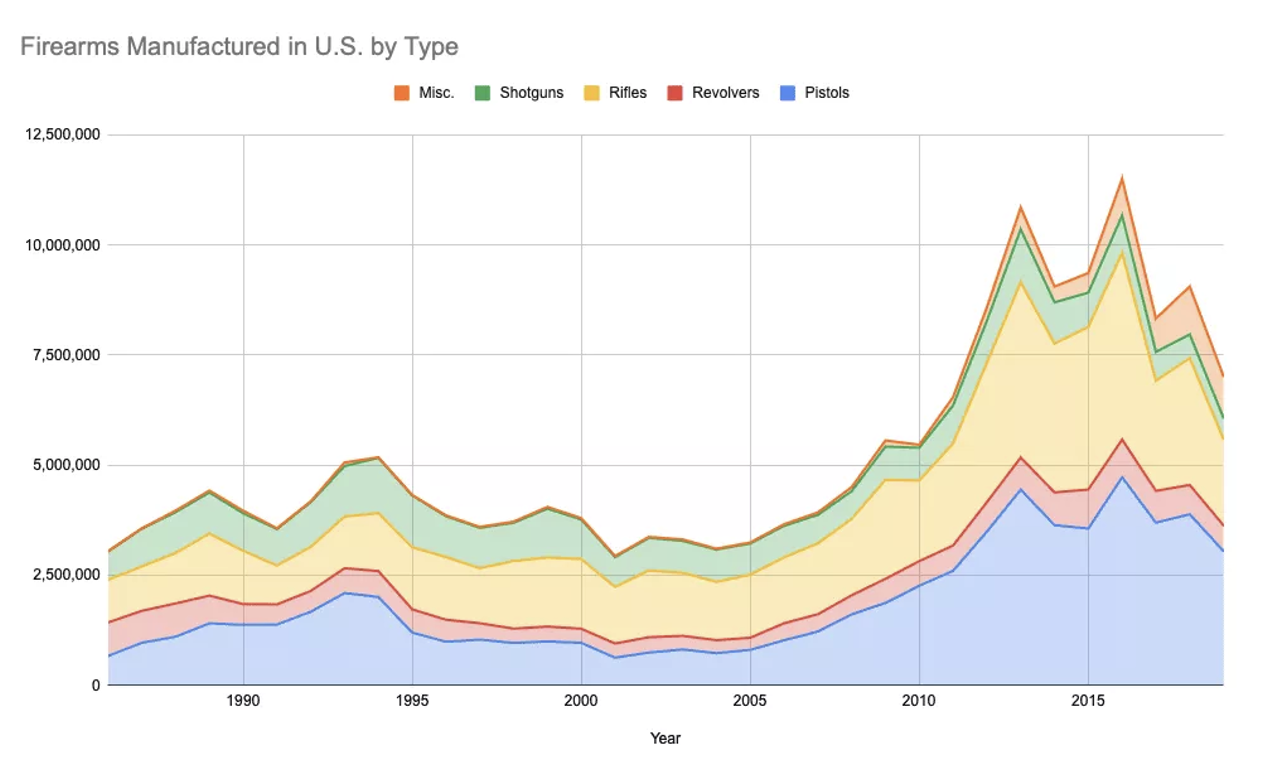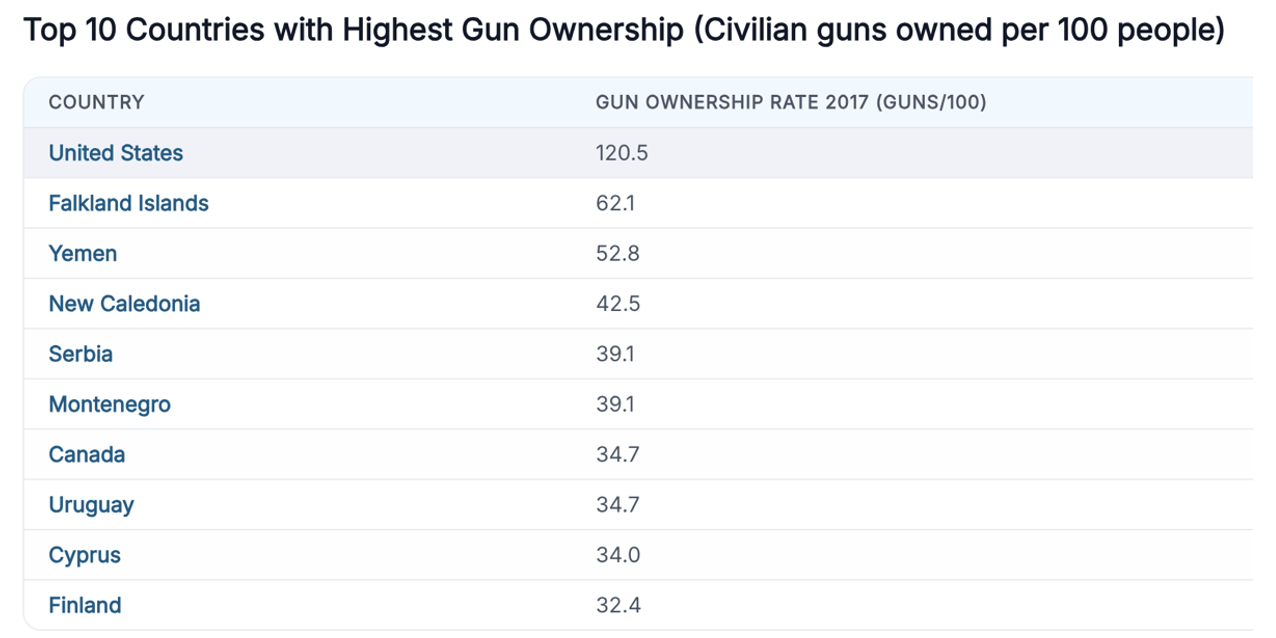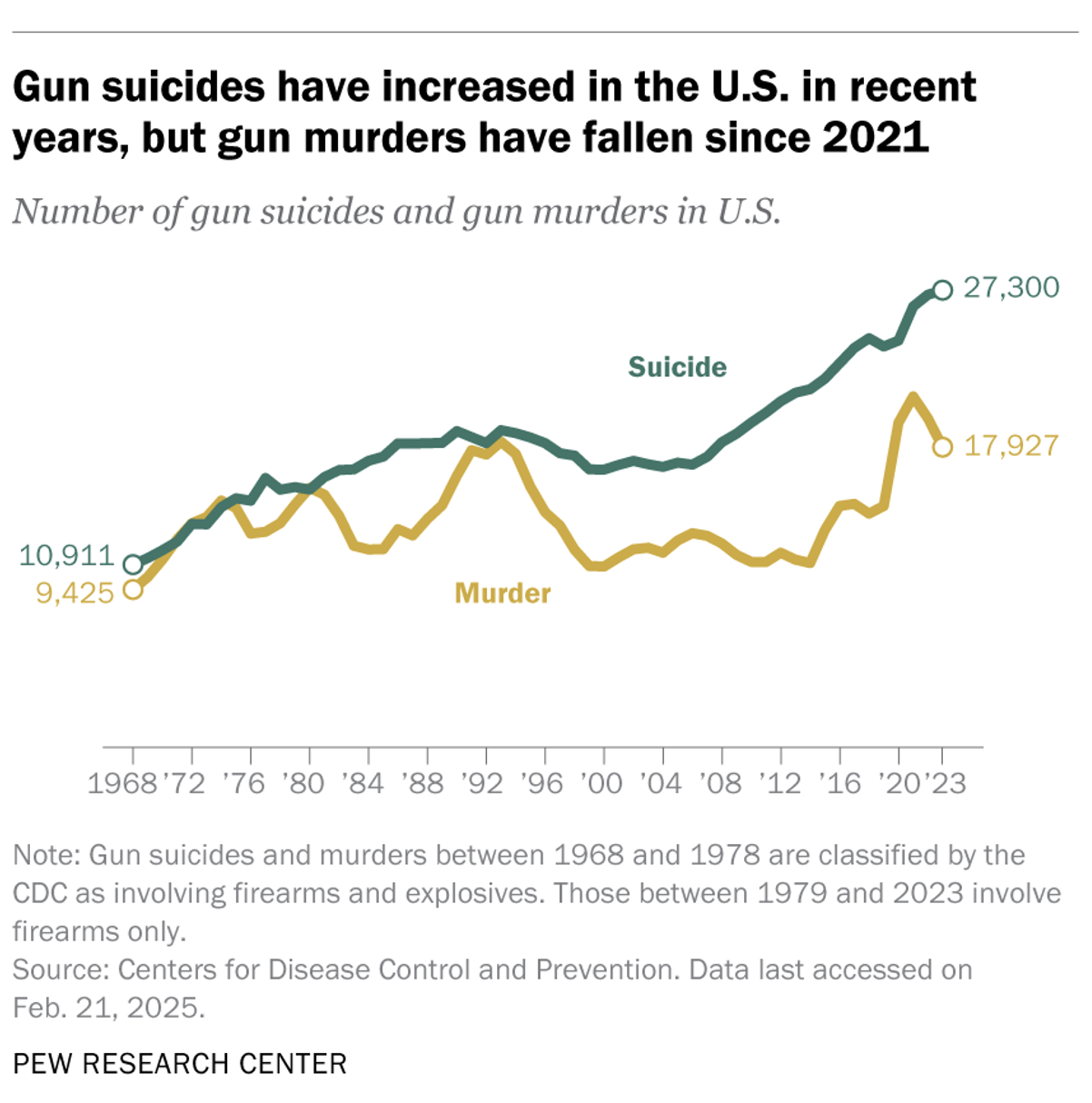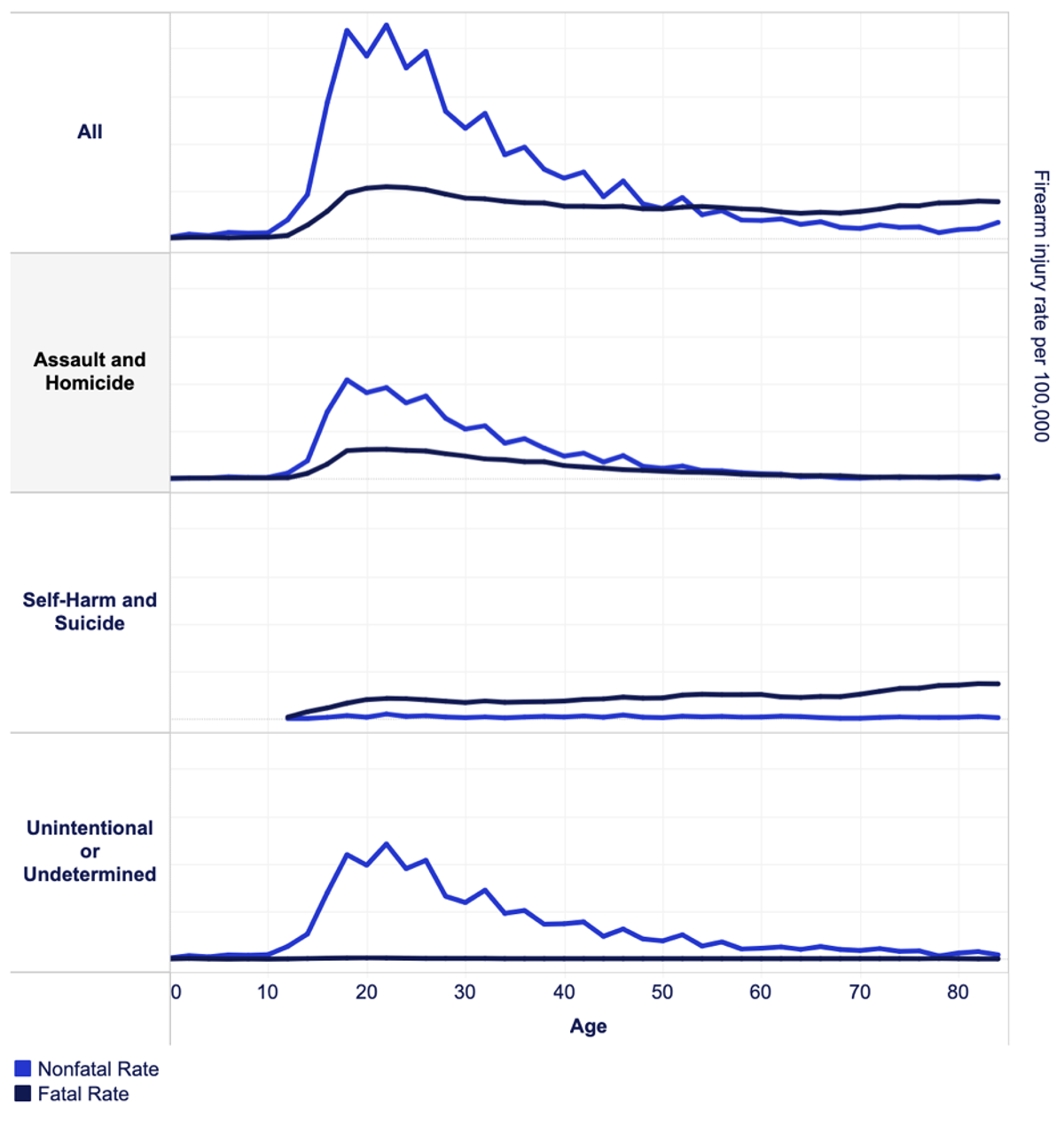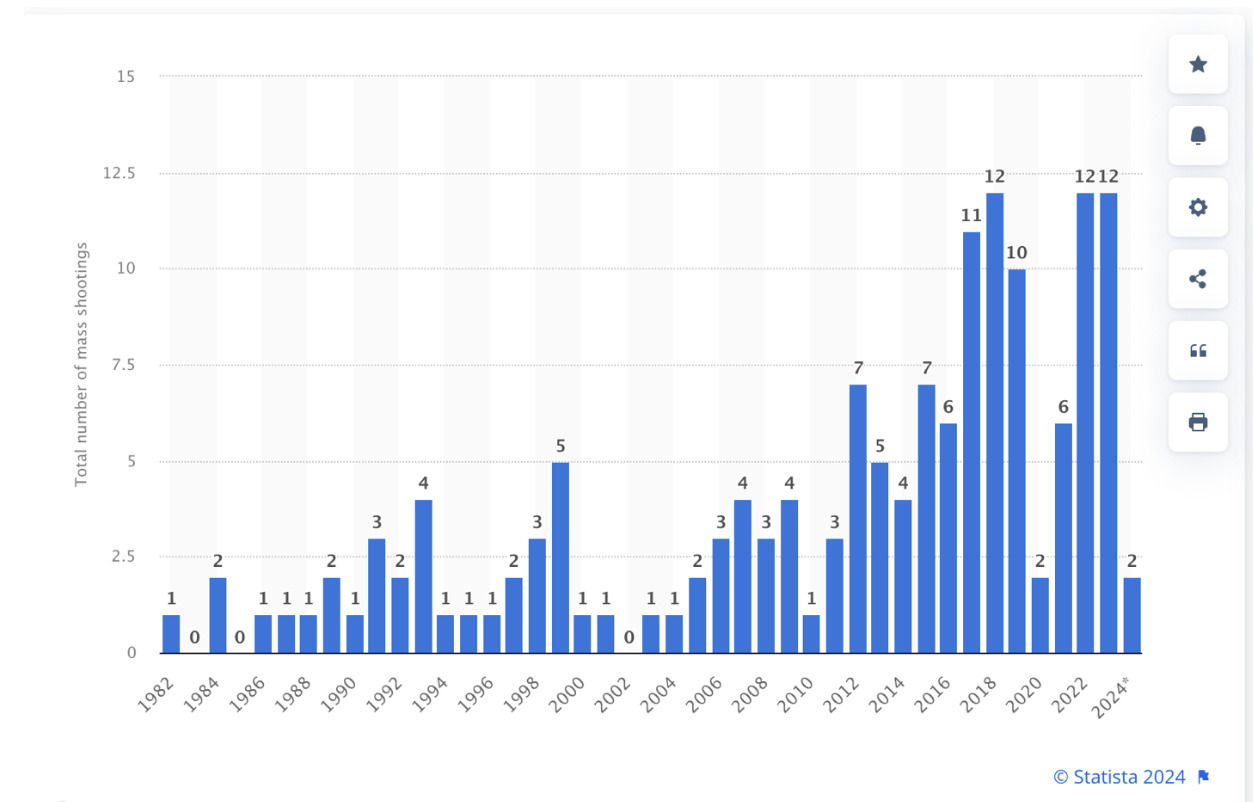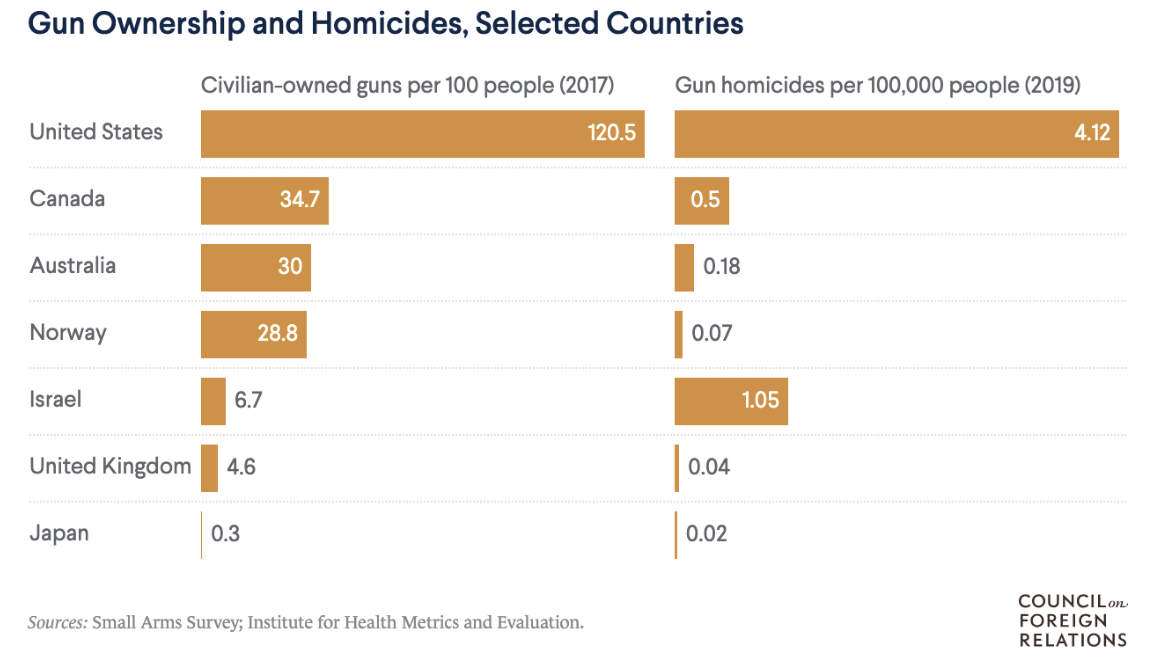Gun Control Research
Explanation of source links: Throughout the research below, you will find links of three types. The first and most frequent type is to primary sources such as governmental agencies. The second is to nonprofit groups that generally use government data or their own research to support their philanthropic mission. We have tried to use the least biased of these, or when in doubt, we have identified their bias. The third is to articles in periodicals or newspapers that we find to be of interest. These are not meant to be construed as original sources, and in some cases may not be accessible, depending on a reader's frequency of prior visits to the linked periodical or newspaper.
How many guns are believed to be in circulation in the US?
The total number of guns in the US is very hard to estimate because not all guns require registration and because of the large number of illegal guns in circulation.
The 2021 National Firearms Survey estimated that Americans collectively owned over 415 million firearms. Within this total, an estimated 171 million were handguns (41%), 146 million were rifles (35.2%), and 98 million were shotguns (23.6%). In a 2018 report, the Small Arms Survey estimated the total number of civilian-held firearms in the US at 393 million. This means that civilians owned 71.5 times more guns than the military and US police combined.
Furthermore, some experts estimate that the real total exceeds these numbers materially. They point to the fact that US law enforcement agencies submitted over 460,000 crime guns for tracing in 2021. According to the Small Arms Survey report, registration data account for only about 12% of guns owned by civilians globally.
Who owns guns in the US?
According to Pew Research 2024, demographically, 38% of White Americans own a gun, compared with 24% of Blacks, 20% of Hispanics, and 10% of Asians. Men are 1.66 times as likely as women (40% vs 25%) to own a gun; gun owners overall are disproportionately male, White, non-urban, and from the South.
How many and what kindS of guns are acquired annually in the US?
Based on the 2022 Annual Firearms Manufacturing and Export Report, upwards of 13 million guns of all kinds were produced and sold by US manufacturers in 2022. Of these, the ATF estimated that approximately 640,000 were exported. In addition, the ATF estimated that 6.8 million firearms were imported in 2016.
SEE ALSO:
Source: Gun University
How does US gun ownership compare to other countries?
Based on the Small Arms Survey 2018 report on global firearms holdings, civilian gun ownership in the US dramatically exceeds the rate of ownership in other countries, as does the total number of guns.
Source: World Population Review
How many deaths each year in the US ARE related to guns? Note: These data include gun-related suicides.
Source: Pew Research
What type of gun are involved in these deaths?
According to Pew Research: “In 2023, the most recent year for which the FBI has published data, handguns were involved in 53% of the 13,529 US gun murders and non-negligent manslaughters for which data is available. Rifles – the category that includes guns sometimes referred to as ‘assault weapons’ – were involved in 4% of firearm murders. Shotguns were involved in 1%. The remainder of gun homicides and non-negligent manslaughters (42%) involved other kinds of firearms or those classified as ‘type not stated.’ ”
What else do we know about gun violence in the US?
Everytown for Gun Safety, a nonprofit dedicated to educating the public on gun violence, is the source of the following data as well as other relevant information. The following chart indicates the relationship between various kinds of gun violence and the ages of those affected.
What do we know about mass shooting deaths?
The question of “mass shooting deaths” is complicated by the fact that there is no generally agreed upon definition of “mass shooting.” The most common definition is an act in which a single gunman kills at least four victims, generally in a single place, and generally indiscriminately. Using this definition, there were 152 mass shootings in the US between 1982 and July 2025. If you include domestic or family violence, as does Everytown for Gun Safety, there were 228 mass shootings between 2009 and 2020. 53% of these were related to domestic or family violence.
For your review, a few of the largest mass shootings in our recent history:
Source: Axios
Are there any identifiable trends in mass shootings in the US?
Yes. The most significant trend is that they are increasing in frequency, as shown in the graph from Statista, which also indicates there were 99 mass shootings between 2011 and 2024. This particular source defines a mass shooting as any single attack in a public place with three or more fatalities, in line with the definition by the FBI.
How does this compare to other developed countries?
According to Everytown Research, the US leads the high-income world in gun homicide rates:
Is there a correlation between gun ownership and gun deaths around the world?
Based on both global and state-by-state data, there appears to be a strong correlation between gun ownership rates and the numbers of gun-related deaths. The Council on Foreign Relations published a useful article comparing US gun ownership, laws, and violence rates to those in other countries (June 10, 2022).
Current gun ownership legislation in the US:
Universal background check states: Nineteen states (California, Colorado, Connecticut, Delaware, Hawaii, Illinois, Maine, Maryland, Massachusetts, Michigan, Nevada, New Jersey, New Mexico, New York, Oregon, Rhode Island, Vermont, Virginia, and Washington) and the District of Columbia generally require universal background checks for all sales of all classes of firearms, whether they are purchased from a licensed dealer or an unlicensed seller. Most of these states' background check laws apply to both sales and other non-temporary firearm transfers, though New Mexico and Virginia exempt transfers that are not made for a fee or other remuneration. Maine only requires background checks on sales by private sellers if those sales are at gun shows or the guns were advertised for sale. Additionally, Pennsylvania requires point of sale background checks for handguns but not for long guns like rifles and shotguns.
Permit requirement states: Instead of (or in addition to) a point-of-sale background check, seven states (Connecticut, Hawaii, Illinois, Massachusetts, Michigan, New Jersey and Oregon) require all firearm purchasers to obtain a permit, issued after a background check, in order to be qualified to acquire any firearm. Illinois also requires unlicensed sellers to contact the State Police at the point-of-sale to verify that the transferee's firearms license remains valid, and requires the State Police to continuously monitor relevant databases to ensure that license holders remain eligible to keep their firearm licenses. Additionally, Minnesota requires a permit and background check for handgun and assault weapon purchases from unlicensed sellers (effective August 1, 2023), and Nebraska has this permit and background check requirement for the purchase of handguns, but not long guns.
Concealed carry: Most states allow people to carry a concealed handgun as long as they have obtained the proper permit. Some states allow people to open carry, meaning that they can have the gun visible on their person.
Licensing and registration: Only a handful of states require handgun owners to license or register them. Some states even have laws on the books that prevent local governments from passing licensing and registration laws. This is generally true for rifles as well.
“Shoot first” laws: 29 states have enacted "shoot first” laws that allow a person to defend themselves in public using deadly force with no duty to retreat. Some of those states have slightly restrictive laws that only apply when a shooter is in a vehicle, and others have weak laws that are defined through a combination of case law, jury decisions, and statutes, and only provide shoot-first protections during criminal trials, among other circumstances.
Gun show and private seller loopholes: Federal law requires background checks for those purchasing guns from licensed dealers, but this leaves a loophole allowing private sellers to conduct a transaction without conducting a background check. 12 states, mostly along the East Coast, have additional laws that extend the background check requirement to private sellers or impose some other regulation on private sellers and/or gun shows. 22 states and the District of Columbia have laws that extend the background check requirement to include some or all private sellers, including sales at gun shows.
What is the history of legislative efforts to regulate gun ownership?
National Firearms Act (NFA) (1934): Part of President Franklin Delano Roosevelt’s “New Deal for Crime,” meant to curtail gangland crimes of that era. The NFA imposed a tax on the manufacturing, selling, and transporting of firearms listed in the law, among them short-barrel shotguns and rifles, machine guns, firearm mufflers, and silencers. The law was only minimally effective in combating organized crime, but some scholars have cited it as a possible reason why automatic weapons, into the present day, are harder to obtain than handguns and rifles. FDR pushed through the NFA with minimal opposition. It was not until the 1960s that a Republican majority on the Supreme Court challenged the law.
Gun Control Act (1968): Passed by a Democratic majority in Congress and signed by Lyndon B. Johnson. Overall, the bill banned importing guns that have “no sporting purpose”; imposed age restrictions for the purchase of handguns (gun owners had to be 21); prohibited felons, the mentally ill, and others from purchasing guns; required that all manufactured or imported guns have a serial number; and imposed “stricter licensing and regulation on the firearms industry.”
Firearm Owners Protection Act (1986): The law enacted protections for gun owners, prohibited a national registry of dealer records, limited ATF inspections to once per year (unless there were multiple infractions), softened what is defined as “engaging in the business” of selling firearms, and allowed licensed dealers to sell firearms at “gun shows” in their state. It also loosened regulations on the sale and transfer of ammunition. This law created the gun show loophole that has been criticized by Democratic politicians for years. It is often cited as one of the reasons for the recent rise in mass shootings.
Brady Handgun Violence Protection Act (1993): The law, which amended the Gun Control Act, required that background checks be completed before a gun is purchased from a licensed dealer, manufacturer, or importer. It also established the National Instant Criminal Background Check System (NICS), which is maintained by the FBI and still used today. This bill received bipartisan support.
Violent Crime Control and Law Enforcement Act (1994): Tucked into this sweeping and controversial act (signed by President Clinton) was a subsection titled the Public Safety and Recreational Firearms Use Protection Act. The provisions of the bill outlawed the ability to “manufacture, transfer, or possess a semiautomatic assault weapon,” unless it was “lawfully possessed under Federal law on the date of the enactment of this subsection.” Nineteen military-style or “copycat” assault weapons—including AR-15s, TEC-9s, MAC-10s, etc.—could not be manufactured or sold. It also banned “certain high-capacity ammunition magazines of more than ten rounds.” The assault rifle ban expired in 2004. Attempts by both the Clinton administration and Democratic members of Congress to extend the provision were met with strong opposition by Republicans and the NRA.
Tiahrt Amendment (2003): Passed by a Republican Congress and signed by President George W. Bush, this law negated several earlier gun control laws. It prohibited the ATF from publicly releasing data showing where criminals purchased their firearms and stipulated that only law enforcement officers or prosecutors could access such information. The law effectively shielded retailers from lawsuits, academic study, and public scrutiny.
Protection of Lawful Commerce in Arms Act (2005): Prevented gun manufacturers from being named in federal or state civil suits by victims of crimes involving guns they made.
What is the National Rifle Association (NRA) and what is their record of congressional support?
The NRA is an American nonprofit organization that advocates for gun rights. Founded in 1871, the group has informed its members about firearm-related legislation since 1934, and it has directly lobbied for and against firearms legislation since 1975. It is considered to be one of the most powerful lobbying groups in the US, based on the strength of nearly 5 million members and an annual budget believed to be around $250 million. Although, historically, the NRA contributed to both Republicans and Democrats, today they almost exclusively support Republicans.
WHAT WAS THE BIDEN ADMINISTRATION’S APPROACH TO GUN POLICY?
The Biden administration implemented several executive actions to address gun violence.
Passed the Bipartisan Safer Communities Act (BSCA), which expanded background checks and funded state-level red-flag laws.
Directly resulting from the BSCA, prosecutions for illegal firearms dealing without a license increased by 52% between 2021 and 2022.
The BSCA also implemented enhanced background checks for gun buyers under 21, resulting in over 77,000 such checks.
Introduced regulations for ghost guns, mandating serial numbers on gun kits to enhance traceability.
Targeted pistol-stabilizing braces, classifying them as short-barreled rifles, thus subjecting them to stricter regulations.
Expanded background checks for gun purchases, aiming to enforce existing laws and reduce gaps in the system.
Launched the Emerging Threats Task Force to combat the rising threat of conversion devices and 3D-printed firearms used in crimes.
WHAT HAS BEEN THE TRUMP ADMINISTRATION’s approach to gun policy?
President Trump issued an executive order on February 7, 2025, ordering his attorney general to review President Biden's gun violence reduction efforts and develop a "plan of action" to roll back four years of gun reforms.
Significant cuts have been proposed to the Bureau of Alcohol, Tobacco, Firearms and Explosives, including a 25% budget cut that would eliminate more than 500 investigators and shrink ATF from 5,136 to 3,671 employees, a 29% reduction.
Department of Government Efficiency (DOGE) staffers have been working on changes at the ATF that would roll back dozens of gun restrictions.
In January 2025, Republican lawmakers with President Trump's support introduced the Constitutional Concealed Carry Reciprocity Act, which would require all states to recognize concealed carry permits issued by any other state.
President Trump’s Department of Justice proposed a new rule that could grant gun rights to many Americans who are currently barred from owning firearms. The executive order suggests that the federal government may move away from strictly adhering to the historical tradition standard established in the Supreme Court’s 2022 New York State Rifle & Pistol Association v. Bruen decision when defending certain firearm regulations.
In Bruen, the Court held that modern gun laws must be justified by a historical tradition of firearm regulation rooted in the 18th or 19th century. This shift signals a potential change in legal strategy by the administration, particularly in cases where it disagrees with the implications of the Bruen ruling.
What was the original purpose of the Second Amendment?
The Second Amendment of the United States Constitution reads: "A well regulated Militia, being necessary to the security of a free State, the right of the people to keep and bear Arms, shall not be infringed."
But, which people were our founding fathers referring to? During the Revolutionary War era, “militia” referred to groups of men who banded together to protect their communities, towns, colonies, and eventually states, once the United States declared its independence from Great Britain in 1776. In the aftermath of the Revolutionary War, many prominent politicians of the time, including our founding fathers, worried that the central government would attempt to disarm state militias. These militias were viewed as an important defense against federal tyranny. The Constitution gave significantly more power to the federal government than it had exercised under the Articles of Confederation. The Second Amendment was part of a compromise to get the support of the anti-federalists.
In June 2008, a seminal Supreme Court case established the right for US citizens to possess firearms. In District of Columbia v. Heller, the Supreme Court meticulously detailed the history and tradition of the Second Amendment, ultimately striking down the DC handgun ban in a five-to-four decision as a violation of US citizens’ Second Amendment right to bear arms.
As we mentioned in the introduction, we do not believe that our founding fathers would have written the Second Amendment as they did were they writing it today. There have been 27 amendments to the Constitution, the most recent in 1992. If the Second Amendment is an obstacle to a civilized society, it should be amended.
How do US gun ownership laws compare to LAWS IN other countries that are free of gun violence?
Canada and Australia are examples of countries that have taken action to reduce gun ownership and gun-related violence.
Canada: As of 1995, a license is required to buy a gun. If it’s a restricted gun, it must be registered and given special approval. Firearms in Canada are divided into three classes: “non-restricted weapons,” such as ordinary rifles and shotguns, “restricted,” such as handguns and semiautomatic rifles/shotguns, and “prohibited,” which includes automatic weapons. Canada requires a 28-day waiting period for purchases, mandatory safety training courses, and more detailed background checks, as well as banning large-capacity magazines and banning or placing greater restrictions on military-style firearms and ammunition.
Australia: The National Agreement on Firearms all but prohibited automatic and semiautomatic assault rifles, mandated licensing and registration, and instituted a temporary gun buyback program that took some 650,000 assault weapons (about one-sixth of the national stock) out of public circulation. Among other things, the law also required licensees to demonstrate a "genuine need" for a particular type of gun and to take a firearm safety course. This led to declining gun death rates and the complete absence of gun-related mass killings in Australia since 1996.
For our specific gun control recommendation, please click here.

